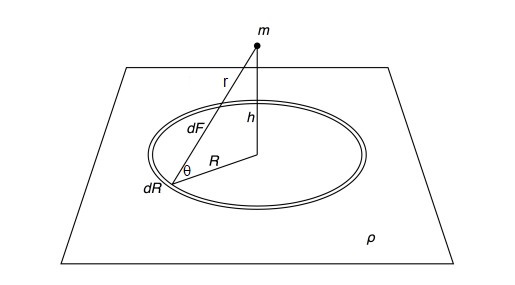
index $ \def \hieruit {\quad \Longrightarrow \quad} \def \slechts {\quad \Longleftrightarrow \quad} \def \SP {\quad ; \quad} \def \MET {\quad \mbox{with} \quad} \def \half {\frac{1}{2}} $
int((x*y+1)/(1+x^2+2*x*y)^(3/2),y=-1..1); latex(%);The first line by MAPLE 8, the rest by hand. The outcome is a (Heaviside) step function. $$ -{\frac {-\sqrt { \left( x-1 \right) ^{2}}x-\sqrt { \left( x-1 \right) ^{2}}+\sqrt { \left( x+1 \right) ^{2}}x-\sqrt { \left( x+1 \right) ^{2}}}{\sqrt { \left( x+1 \right) ^{2}}\sqrt { \left( x-1 \right) ^{2}}}} \\ = - \left[-\frac{x}{|x+1|}-\frac{1}{|x+1|}+\frac{x}{|x-1|}-\frac{1}{|x+1|}\right] = \frac{x+1}{|x+1|}-\frac{x-1}{|x-1|} = 1-\frac{x-1}{|x-1|} \\ \\ \hieruit \int_{-1}^{+1} \frac{xy+1}{(1+x^2+2xy)^{3/2}}dy = \begin{cases} 2 \quad \mbox{for} \quad x \le 1 \\ 0 \quad \mbox{for} \quad x \ge 1 \end{cases} $$ It follows that $$ F(R) = - 2\pi\,G\,\rho\,R\,m\left[\int_0^1 2\,x^2\,dx + \int_1^\infty 0\,x^2\,dx\right]= - \frac{4}{3}\,\pi\,G\,\rho\,R\,m $$
 | The Paradox of Newtonian Gravitation is in the fact that, according to the above calculations, any test mass $\,m\,$ anywhere in the universe is being attracted (with a force $\,-F\,$) towards the center $C$ of a (spherical) coordinate system, which is also an arbitrary point in the universe. The paradox can be derived in a much simpler way by employing two well known results in gravity theory. Both are a consequence of Newton's Shell theorem. The first result is that the force upon a test mass inside a hollow sphere is exactly zero. The second result is that the force upon a test mass outside a massive sphere is the same as the force towards a point at the center of the sphere with the total mass of the sphere concentrated in it. Therefore the total force is simply $\,F = - G\,m(\rho\cdot 4/3\pi R^3)/R^2 = -4/3\,\pi\,G\,\rho\,R\,m\,$ , quite in concordance with the more elaborate theory. |
g(x,alpha) := int(exp(-alpha*sqrt(1+x^2+2*x*y))*(x*y+1)/(1+x^2+2*x*y)^(3/2),y=-1..1);
F := int(g(x,alpha)*x^2,x=0..infinity);
simplify(%,assume=positive);
0
Fortunately, there are people on the internet much smarter than me and others. So here comes the proof that I've been waiting for.
It's entirely by hand: Brain on, computer off !Why am I so motivated by this problem? Take a look at equation (2) in the paper by Amitabha and Ujjal. It's because our version of the Variable Mass Theory (UAC) comes in with Laplace's modification of the law of gravitation. It's reasonable to assume that the test mass $\,m\,$ is located near us, here and now. If the other infinitesimal masses $\,d\mu = \rho\,dV\,$ in the universe are at large distances $\,r\,$ from us, as is usually the case with cosmology, then we are looking backwards in the past $\,(t_0-t)\gt 0\,$ and the corresponding variable masses have been smaller at that time, according to (boxed) formulas in the Hubble Parameter section: $$ \frac{d\mu}{d\mu_0} \large = e^{-H(t_0-t)} = e^{-H/c_0\,\cdot\, r} $$ where $H=$ (intrinsic) Hubble parameter :-(with tension)-: and $c_0=$ speed of light in empty space. It's easy to see now that Laplace's factor must be $$ \exp(-\Gamma\cdot r) = \exp(-H/c_0\cdot r) \hieruit \boxed{\large \Gamma = \frac{H}{c_0}} $$ Pierre-Simon's constant can be calculated now.
# 1 megaParsec
Mpc := 3.08567758*10^22;
# Hubble parameter (2022-02-08)
H := 73.4*1000/Mpc;
# Speed of light
c_0 := 299792458;
# Gamma
H/c_0;
-26
0.7934595873 10
It turns out to be very small indeed, approximately $\,8 \times 10^{-27}\, m^{-1}$. By the way, this is $\approx$ twice
the value as found by Amitabha Ghosh at page 47 in his book Origin of Inertia.
h*int(R*exp(-Gamma*sqrt(R^2+h^2))/(R^2+h^2)^(3/2),R=0..infinity);
f(h) := simplify(%,assume=positive);
int(f(h),h=-infinity..infinity);
0
Come on! It must be possible again to do this with Brain on, computer off !
Define $\,I\,$ as half the above integral:
$$
I = \int_0^{\infty} h \left[ \int_0^{\infty} \frac{e^{-\Gamma\sqrt{R^2+h^2}}R\,dR}{(R^2+h^2)^{3/2}}\right] dh \\
u = \sqrt{R^2+h^2} \SP v = \frac{h}{\sqrt{R^2+h^2}} \SP h = uv
\SP du\,dv = \frac{\partial(u,v)}{\partial(R,h)}dR\,dh = \left| J \right| dR\,dh
$$
From the picture we see that $\,u=r\,$ and $\,v=\sin(\theta)\,$,
giving the integration bounds $\,0\le u \lt\infty\,$ and $\,0\le v \le 1\,$.
$$
\left| J \right| = \begin{vmatrix} \partial u/\partial R & \partial u/\partial h \\
\partial v/\partial R & \partial v/\partial h \end{vmatrix} =
\begin{vmatrix} R/\sqrt{R^2+h^2} & h/\sqrt{R^2+h^2} \\ -Rh/(R^2+h^2)^{3/2} & 1/\sqrt{R^2+h^2} - h^2/(R^2+h^2)^{3/2} \end{vmatrix}
= \frac{R}{R^2+h^2} \\
u^2 = R^2+h^2 \hieruit R^2 = u^2-h^2 = u^2(1-v^2) \hieruit R = u\sqrt{1-v^2} \hieruit \left| J\right| = \frac{\sqrt{1-v^2}}{u} \\
I = \iint uv \cdot \frac{e^{-\Gamma\,u}\,u\sqrt{1-v^2}}{u^3} \left(\frac{u}{\sqrt{1-v^2}}\right)du\,dv =
\int_0^\infty e^{-\Gamma\,u}\,du \cdot \int_0^1 v\,dv = \frac{1}{2\Gamma}
$$
If the force components on the test particle from below and from above are considered separately,
then we observe that each of the corresponding integrals is equal to the same (extremely large) value.
So these finite outcomes neatly cancel each other out. Formally, with $\,g=-h\,$:
$$
F = 2\pi G m \rho \left\{ \int_{-\infty}^{0} h \left[ \int_0^{\infty} \frac{e^{-\Gamma\sqrt{R^2+h^2}}R\,dR}{(R^2+h^2)^{3/2}}\right] dh
+ \int_{0}^{\infty} h \left[ \int_0^{\infty} \frac{e^{-\Gamma\sqrt{R^2+h^2}}R\,dR}{(R^2+h^2)^{3/2}}\right] dh \right\} \\
F = 2\pi G m \rho \left\{ - \int_0^\infty g \left[ \int_0^{\infty} \frac{e^{-\Gamma\sqrt{R^2+g^2}}R\,dR}{(R^2+g^2)^{3/2}}\right] dg
+ \int_{0}^{\infty} h \left[ \int_0^{\infty} \frac{e^{-\Gamma\sqrt{R^2+h^2}}R\,dR}{(R^2+h^2)^{3/2}}\right] dh \right\} \\
F = 2\pi G m \rho \left\{ - \frac{1}{2\Gamma} + \frac{1}{2\Gamma} \right\} = 0
$$
The physical meaning of $\,1/\Gamma=c_0/H\,$ is the speed of light times a Hubble time. Which in some circles is called the size
of the (observable) universe. Thus what we finally have is the force exerted on the test particle by half the universe
below it, canceled by the force of half the universe above it. So to speak. Whatever. Whether the so-called
Observable universe has a radius or not,
it anyway has sort of a decay distance $\,1/\Gamma\,$ in the exponential function $\,\exp(-\Gamma\,r)\,$.
And this (not expanding / not comoving) characteristic very much Euclidean distance is calculated to be
# Seconds in a year
year := 31556926;
# 1/Gamma
c_0/H/(c_0*year)/10^9;
13.32170443 # 13 billion light years